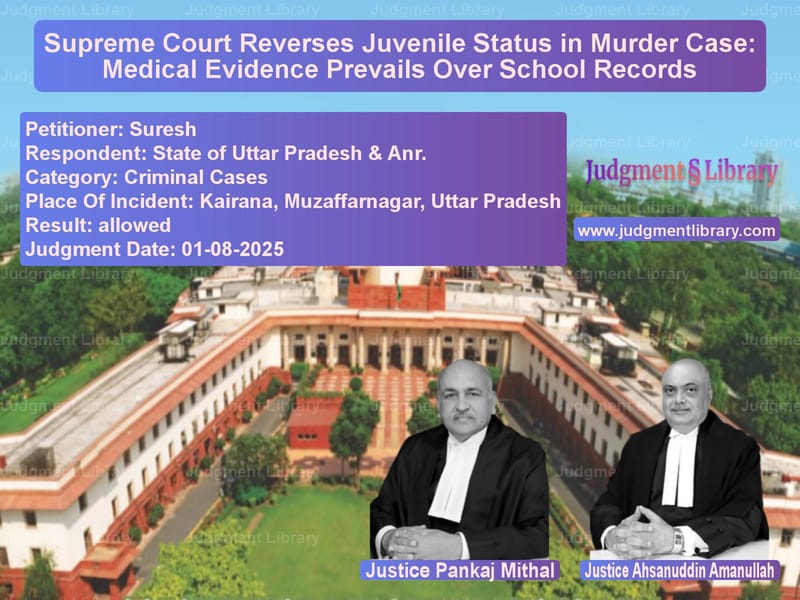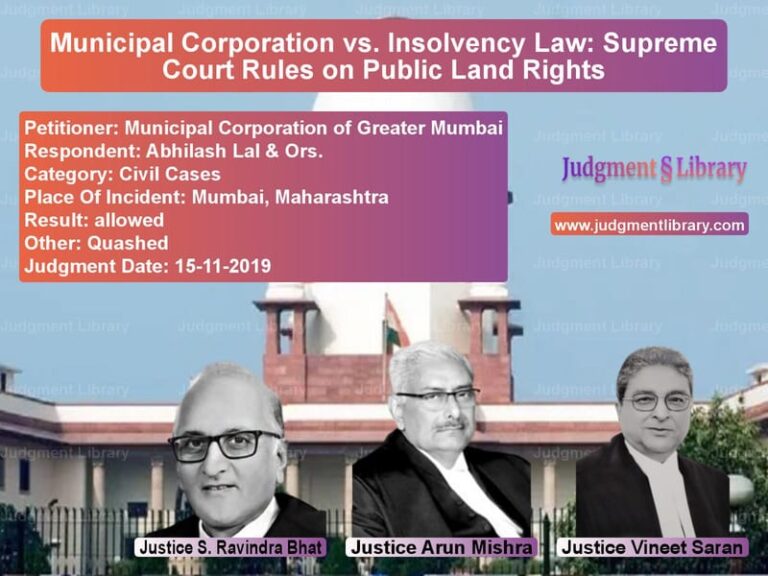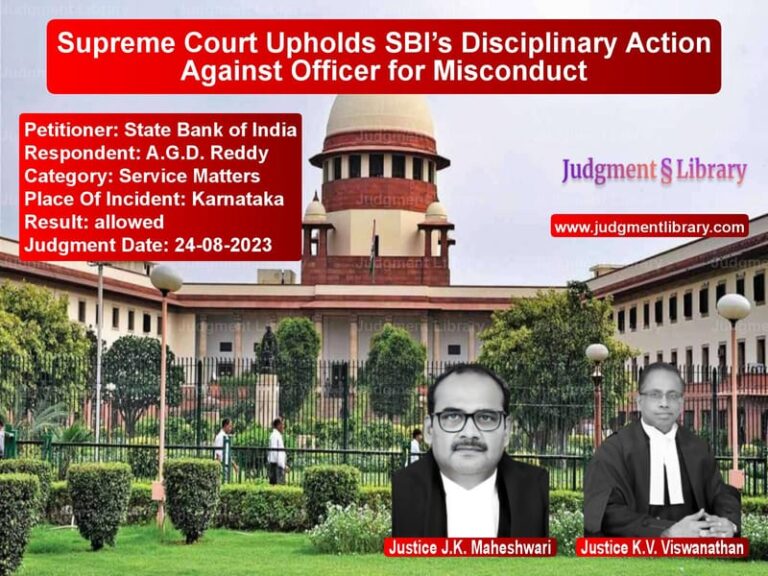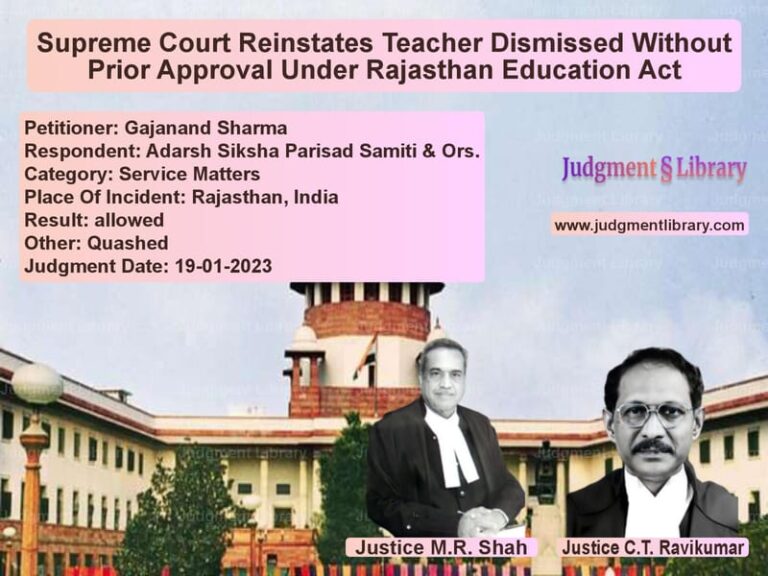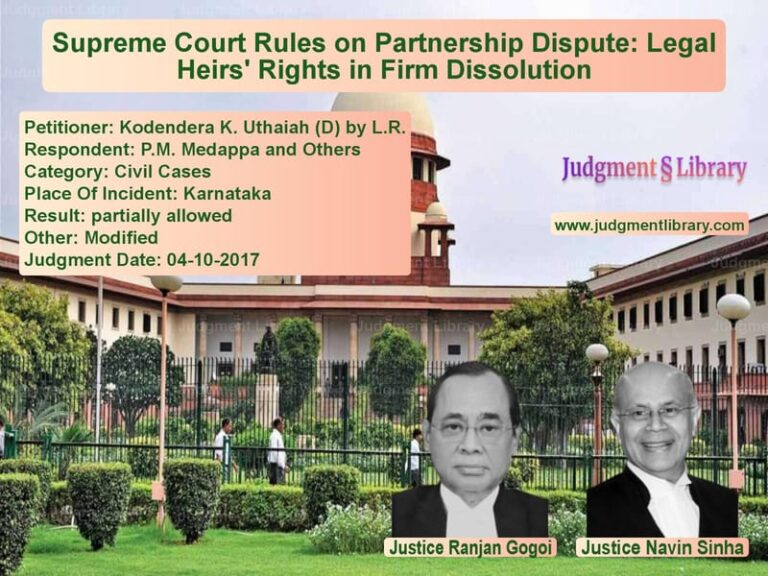Supreme Court Reverses Juvenile Status in Murder Case: Medical Evidence Prevails Over School Records
In a significant ruling that underscores the importance of reliable evidence in determining juvenile status, the Supreme Court of India recently delivered a judgment that reversed the findings of two lower courts in a murder case. The case involved a complex dispute over whether an accused person was a juvenile at the time of committing a serious crime, with conflicting evidence from school records, government documents, and medical examinations creating a legal puzzle that required the highest court’s intervention.
The tragic incident that sparked this legal battle occurred on August 31, 2011, in Kairana, Muzaffarnagar, Uttar Pradesh. According to the prosecution, the appellant’s brother, Rajesh Singh, was allegedly shot and killed by Devi Singh (Respondent No. 2) after a family altercation. The prosecution claimed that Respondent No. 2 and his father forcibly entered the appellant’s house, manhandled his wife, and later took Rajesh to their house where Respondent No. 2 fired a country-made pistol at him, causing fatal injuries.
The Juvenile Justice Claim
Following the registration of FIR Crime Case No. 385/2011 under Sections 452 and 302 of the Indian Penal Code, Respondent No. 2 filed an application before the Trial Court claiming juvenility. He asserted that his date of birth was April 18, 1995, which would make him 16 years, 4 months, and 13 days old at the time of the incident – well below the 18-year threshold for juvenile status under the Juvenile Justice (Care and Protection of Children) Act, 2000.
The Trial Court, after examining the evidence, accepted this claim and declared Respondent No. 2 a juvenile on May 19, 2015. When the appellant challenged this decision before the Allahabad High Court, the revision petition was dismissed on March 29, 2016, upholding the juvenility declaration. This led to the current appeal before the Supreme Court.
Conflicting Evidence and Legal Arguments
The appellant’s counsel presented a compelling case against the juvenility claim, pointing to multiple documentary evidence that contradicted the school certificates. “The Appellant’s submissions majorly revolved around pointing out how the Courts below erred in establishing and confirming the Respondent No.2’s juvenility based on a transfer certificate issued by the first school attended by Respondent No.2,” the court noted.
The appellant relied on three key pieces of evidence that suggested Respondent No. 2 was actually an adult at the time of the incident. First, the Family Register maintained under the U.P. Panchayat Raj Act, 1947 by the Gram Panchayat declared Respondent No. 2’s year of birth as 1991, which would make him approximately 20 years old in 2011. Second, the Voters’ List from 2012 showed Respondent No. 2’s age as 22 years as of January 1, 2012. Third, and perhaps most significantly, a medical examination conducted by the Chief Medical Officer on December 1, 2012, determined Respondent No. 2’s age to be about 22 years at that time.
The appellant’s counsel argued that “Section 35 of the Evidence Act would be attracted both in civil and criminal proceedings” and cited the precedent in Birad Mal Singhvi v Anand Purohit, which held that “An entry relating to date of birth made in the school register is relevant and admissible under section 35 of the Act, but the entry regarding the age of a person in a school register is of not much evidentiary value to prove the age of the person in the absence of the material on which the age was recorded.”
Furthermore, the appellant relied on Om Prakash v State of Rajasthan, where the Supreme Court had held that “in cases of serious offences like murder, rape, etcetera, an accused cannot be allowed to abuse the statutory protection afforded to him by attempting to prove himself as a minor when the documentary evidence to prove his minority gives rise to a reasonable doubt about his assertion of minority.”
The State of Uttar Pradesh supported the appellant’s position, arguing that since Respondent No. 2 had produced neither a birth certificate nor a matriculation certificate, the transfer certificate alone shouldn’t determine juvenility, especially when contradicted by the Voters’ List, Family Register, and Medical Report.
Respondent No. 2’s counsel presented a three-fold defense. First, they argued that the Trial Court had correctly established juvenility based on consistent date of birth recordings across multiple school transfer certificates. Second, they emphasized that Rule 12 of the Juvenile Justice Rules provided a hierarchy of documents for age determination, where the certificate from the first school attended should be considered when matriculation certificates are unavailable. Third, they noted that Respondent No. 2 had already been released by the Juvenile Justice Board after completing the maximum three-year punishment prescribed for juveniles.
The Supreme Court’s Analysis
The Supreme Court bench comprising Justices Pankaj Mithal and Ahsanuddin Amanullah conducted a thorough analysis of the evidence and legal principles. The court began by observing that “the approach adopted by the Trial Court as well as the High Court was not proper. Though the issue of juvenility, indubitably and primarily has to be determined as per the relevant provisions of the Juvenile Justice Act and the Rules framed thereunder, as applicable at the relevant time, yet under appropriate circumstances and with justifiable reasons, the Court examing the issue has the discretion to take other relevant materials and factors into account, for ultimately the cause of justice has to prevail.”
The court examined Rule 12(3) of the Juvenile Justice Rules, which establishes a sequential approach to age determination: first, matriculation certificates; second, date of birth certificate from the first school attended; third, birth certificate from municipal authorities; and only in the absence of these, medical opinion.
However, the court found serious reliability issues with the school certificate from Kaushik Modern Public School, which was the foundation for all subsequent school records. “The first school certificate issued by Kaushik Modern Public School, Khurgaon, where Respondent No.2 was admitted in Class V, records his date of birth as 18.04.1995. Pausing here, it is also relevant to indicate that the Headmaster of the said School while deposing has stated that this birth-date entry was made only on an oral representation by Respondent No.2’s father.”
The court made crucial observations about the evidentiary value of the school records: “There is no dispute on the factum that Kaushik Modern Public School, Khurgaon – the first attended school – is not a Government School and thus, the records maintained by the said School would not be ‘public documents’. Moreover, the Headmaster/Principal of such School cannot be said to be a ‘public servant’ for the purposes of the Evidence Act.”
The court further noted that “the Principal has also stated that the birth-date entry was made on the basis of an oral representation alone by Respondent No.2’s father and when he was asked for the horoscope or any other document in support of the date of birth of the Respondent No.2, nothing was submitted. This, in our view, discredits the certificate issued by the Kaushik Modern Public School, Khurgaon.”
Precedent and Principles
The Supreme Court extensively relied on its earlier decision in Om Prakash v State of Rajasthan, quoting several significant passages: “Hence, while the courts must be sensitive in dealing with the juvenile who is involved in cases of serious nature like sexual molestation, rape, gang rape, murder and host of other offences, the accused cannot be allowed to abuse the statutory protection by attempting to prove himself as a minor when the documentary evidence to prove his minority gives rise to a reasonable doubt about his assertion of minority. Under such circumstance, the medical evidence based on scientific investigation will have to be given due weight and precedence over the evidence based on school administration records which give rise to hypothesis and speculation about the age of the accused.”
The court also emphasized that “The benefit of benevolent legislation under the Juvenile Justice Act obviously will offer protection to a genuine child accused/juvenile who does not put the court into any dilemma as to whether he is a juvenile or not by adducing evidence in support of his plea of minority but in absence of the same, reliance placed merely on shaky evidence like the school admission register which is not proved or oral evidence based on conjectures leading to further ambiguity, cannot be relied upon in preference to the medical evidence for assessing the age of the accused.”
The judgment further cautioned that “The Juvenile Justice Act which is certainly meant to treat a child accused with care and sensitivity offering him a chance to reform and settle into the mainstream of society, the same cannot be allowed to be used as a ploy to dupe the course of justice while conducting the trial and treatment of heinous offences. This would clearly be treated as an effort to weaken the justice dispensation system and hence cannot be encouraged.”
The Final Ruling
After weighing all evidence, the Supreme Court concluded that “the certificate issued by Kaushik Modern Public School, Khurgaon could not have been taken as conclusive proof of date of birth of Respondent No.2, discarding Form (A) under Rule 2 of the Rules under the U. P. Panchayat Raj Act, 1947; the entry in the Voters’ List for the Legislative Assembly of the year 2012, and; the Medical Report. On the basis of the latter three documents, it is clear that Respondent No.2 cannot be said to have been a ‘juvenile’ on the date of the unfortunate incident.”
The court accordingly allowed the appeal and set aside the orders of the Trial Court and High Court declaring Respondent No. 2 as a juvenile. The court held that “Respondent No.2 is held to have been a major as on the date of commission of the alleged offence and liable to be tried as a major for Crime No. 385/2011.”
The Supreme Court directed the Trial Court to expedite the trial and conclude it by the end of July 2026. Respondent No. 2 was directed to appear before the Trial Court within three weeks and was given liberty to apply for bail. The court also set aside the order directing his release under the Juvenile Justice Act, while noting that if convicted, he would receive set-off for the three years already spent in juvenile facility.
Broader Implications
This judgment has significant implications for the Indian justice system, particularly in cases involving serious crimes where the accused claims juvenile status. The Supreme Court has sent a clear message that while the Juvenile Justice Act is a benevolent legislation meant to protect genuine minors, it cannot be used as a shield by adults accused of heinous crimes.
The ruling emphasizes that courts must take a comprehensive view of all available evidence when determining age, rather than mechanically following the hierarchy established in the Juvenile Justice Rules. When school records are unreliable or based on mere oral representations, and when they conflict with statutory documents and medical evidence, courts have the discretion to prefer the latter.
This case also highlights the importance of maintaining reliable birth registration systems and proper documentation in schools. The fact that a person’s age could be recorded in school records based solely on oral representation by a parent, without supporting documents, reveals significant gaps in our system that can be exploited.
Ultimately, the Supreme Court’s decision reinforces the principle that justice must prevail over technicalities, especially in serious cases like murder where the determination of whether an accused should be tried as an adult or juvenile has profound implications for both the victim’s family and the accused.
Petitioner Name: Suresh.Respondent Name: State of Uttar Pradesh & Anr..Judgment By: Justice Pankaj Mithal, Justice Ahsanuddin Amanullah.Place Of Incident: Kairana, Muzaffarnagar, Uttar Pradesh.Judgment Date: 01-08-2025.Result: allowed.
Don’t miss out on the full details! Download the complete judgment in PDF format below and gain valuable insights instantly!
Download Judgment: suresh-vs-state-of-uttar-prade-supreme-court-of-india-judgment-dated-01-08-2025.pdf
Directly Download Judgment: Directly download this Judgment
See all petitions in Murder Cases
See all petitions in Juvenile Justice
See all petitions in Bail and Anticipatory Bail
See all petitions in Attempt to Murder Cases
See all petitions in Custodial Deaths and Police Misconduct
See all petitions in Other Cases
See all petitions in Judgment by Pankaj Mithal
See all petitions in Judgment by Ahsanuddin Amanullah
See all petitions in allowed
See all petitions in supreme court of India judgments August 2025
See all petitions in 2025 judgments
See all posts in Criminal Cases Category
See all allowed petitions in Criminal Cases Category
See all Dismissed petitions in Criminal Cases Category
See all partially allowed petitions in Criminal Cases Category

